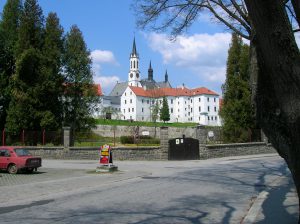Vyšší Brod Monastery
By Tracy A. Burns
Not far from the enchanting Zlatá Koruna Monastery and the bewitching town of Český Krumlov with its Renaissance facades and remarkable castle, the Cistercian monastery Vyšší Brod is nestled in the Šumava mountains region of southern Bohemia. Now once again the property of the Cistercian Order, the monastery, founded in 1259 and built over a period of 100 years, still retains a Gothic appearance with features of both Early and Late Gothic architecture. The church, the library, and the painting gallery are all enthralling.
The Church
 The church astounds with its high altar and side altar of the Virgin Mary. Built from 1644 to 1646, the Early Baroque high altar is made of brown gilded wood and is adorned with statues. Saint Eugene the Pope and Saint Bernard make appearances as does Saint Robert of Molesme and Saint Benedict. A sculpture of the Crowning of the Virgin Mary and another of the Holy Trinity round out this gem.
The church astounds with its high altar and side altar of the Virgin Mary. Built from 1644 to 1646, the Early Baroque high altar is made of brown gilded wood and is adorned with statues. Saint Eugene the Pope and Saint Bernard make appearances as does Saint Robert of Molesme and Saint Benedict. A sculpture of the Crowning of the Virgin Mary and another of the Holy Trinity round out this gem.
The side altar of the Virgin Mary boasts a valuable panel painting of the Madonna of Vyšší Brod by the Master of Vyšší Brod after 1400. Set against a golden background, the blond Mother of God cradles a naked baby Jesus while angels hover above her and saints pose at the sides.
Abbots’ tombstones fill the church as well. Some have been forged in Mannerist style while others hail from the Baroque era. A wood inlaid and the gilded choir are studded with Baroque statues of various saints. The exquisite Gothic stained glass windows are decorated with themes from the lives of the saints.
The Library
The library holds 70,000 volumes, making it the third-largest Czech monastic library as it falls behind only Strahov and Teplá. The Rococo bookcases date from 1756. Works from 1500 to 1800 make up part of the collection, though some pieces date as far back as the 13th century, such as the Psalterium that includes the Book of Psalms and The Old Testament. A five-volume Latin Bible dates from the early 14th century. Chants of the Cistercian Order hail from the turn of the 15th century.
The Library Corridor is home to 19th century and early 20th century collections written mostly in Latin and German. Books about subjects such as math, biology, and chemistry are stored in the Philosophical Hall. Along with a remarkable ceiling fresco, Latin quotations by Saint Bernard promoting education dominate this space. In the center of the room, a detailed map of the Czech lands features even the tiniest villages from the 1600s.
The Theological Hall is best known for keeping one of the largest collections of Bibles in Central Europe, and these holy books are written in 40 languages. The white pigskin bindings hail from the middle of the 18th century. The ceiling fresco shows a 12-year-old Jesus in a temple. Look closely, though: some of the objects featured in the fresco didn’t exist in the era when Jesus lived. For example, one man dons glasses, another holds a book, and there is a glass window. The style of clothing and the architecture are also ahead of their time.
The Art Collection
The art collection is yet another highlight of Vyšší Brod. Focusing on Gothic and Baroque works, the gallery features many Dutch and Flemish creations as well as Baroque renditions by Czech artists such as the renowned Petr Brandl. Baroque seascapes and landscapes by Norbert Grund, František Xavier Palko’s portrayal of the 12 apostles, a portrait by Czech master Jan Kupecký and many floral still lifes make up the exhibition. Illustrated manuscripts and exquisite porcelain are also on display.
The Early Baroque high altar, the Gothic Madonna of Vyšší Brod, one of the largest collections of Bibles in Central Europe, and Dutch and Flemish paintings are just a few of the compelling sights that make up this Šumava-based monastery with a striking Gothic appearance. Its location near Zlatá Koruna and Český Krumlov is another plus. Visiting Vyšší Brod Monastery is sure to be an unforgettable, enriching experience.




